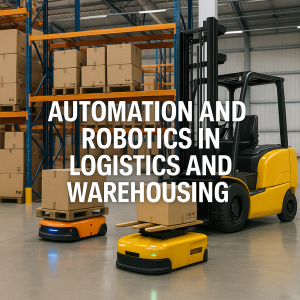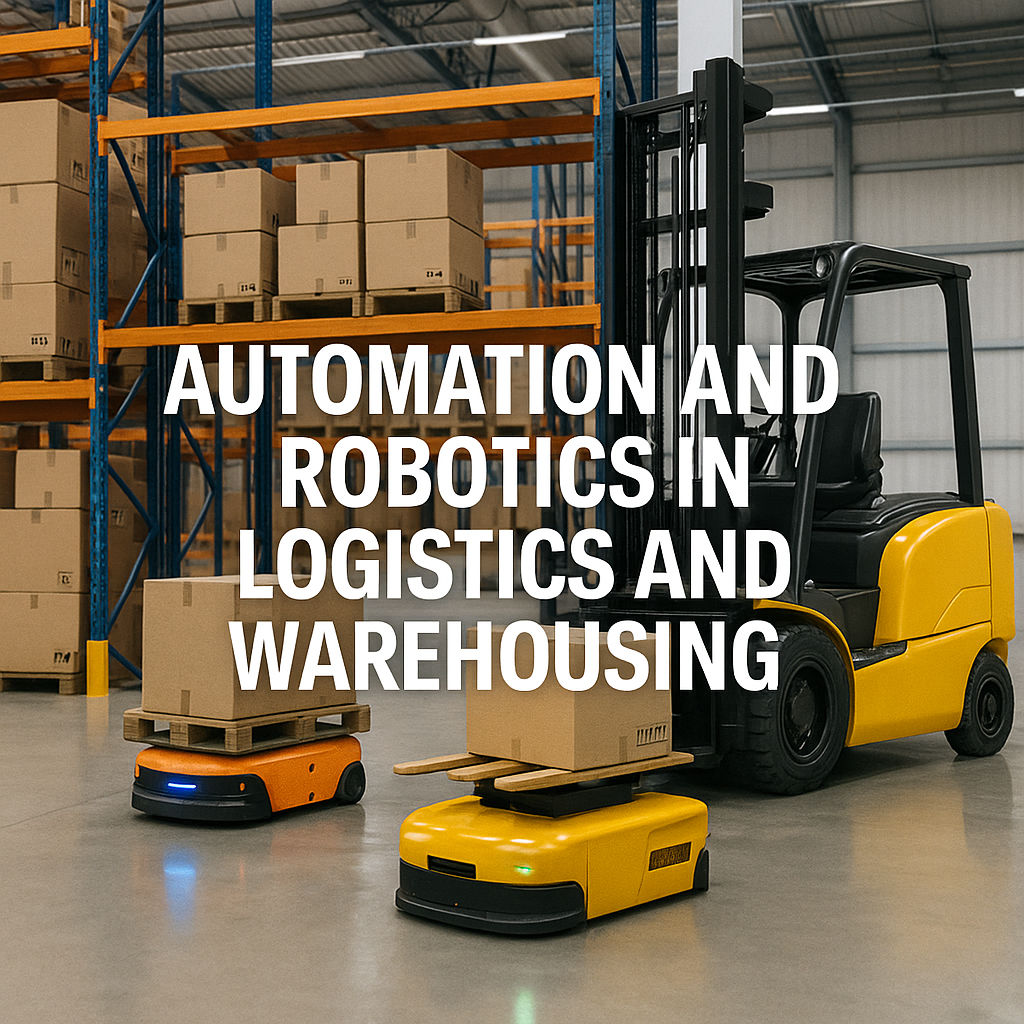
Discover how automation and robotics are reshaping logistics and warehousing in 2025. From AI-powered picking to autonomous forklifts and smart ports, explore key trends, challenges, and the future outlook of maritime supply chains.
Why Automation and Robotics Matter in Modern Logistics
In today’s fast-paced global economy, goods don’t just travel from factory to port—they journey through vast, complex webs of warehouses, container yards, and distribution centers. These facilities, once dominated by manual labor and paper-based systems, are now turning into automated ecosystems where robotics, artificial intelligence, and data analytics run the show.
For maritime logistics in particular, automation is no longer a distant concept. The pressure of e-commerce growth, port congestion, rising labor shortages, and sustainability regulations means companies are seeking faster, safer, and more resilient solutions. According to UNCTAD’s Review of Maritime Transport (2023), over 80% of global trade by volume still travels by sea, and much of it depends on warehouses and distribution centers. The efficiency of these hubs directly affects port performance, ship turnaround times, and ultimately, the flow of global commerce.
Automation in logistics isn’t just about shiny robots. It is about making supply chains smarter, more adaptive, and more human-friendly—freeing workers from repetitive tasks while reducing risks, costs, and emissions.
Key Technologies Driving Change in Warehousing and Logistics
Automated Guided Vehicles (AGVs) and Autonomous Mobile Robots (AMRs)
Think of AGVs as the “self-driving cars” of warehouses. These vehicles transport pallets, containers, or packages without human drivers, guided by sensors and digital maps. Unlike older AGVs that followed fixed tracks, modern AMRs (Autonomous Mobile Robots) can adjust routes in real time, avoiding obstacles and collaborating with humans.
For example, Amazon Robotics uses fleets of AMRs to move shelves of goods in fulfillment centers, reducing picking time by up to 40%. In port-linked warehouses, KION Group and Toyota Material Handling are developing heavy-duty AGVs to handle containers seamlessly.
Robotic Picking and Packing
Picking—the act of selecting the right item from thousands in storage—has traditionally been one of the most labor-intensive tasks. Robotic arms, equipped with AI vision systems, now identify, grip, and move items with remarkable precision. Companies like Ocado (UK) and GreyOrange (Singapore) are deploying robotic pickers that handle over 50–70 items per minute.
In maritime logistics, this technology ensures that goods are packed into containers faster, reducing port dwell times.
Automated Storage and Retrieval Systems (AS/RS)
High-rise warehouses are increasingly fitted with AS/RS, where robotic shuttles move vertically and horizontally to store or retrieve goods. This maximises cubic space, reduces picking errors, and speeds up order fulfillment.
In Rotterdam and Hamburg, automated container terminals already integrate AS/RS with port operations, creating near-seamless cargo transfer.
Drones in Warehousing and Ports
While drones are often associated with last-mile delivery, they are now being deployed inside warehouses for inventory checks, barcode scanning, and security surveillance. DHL and Maersk have trialed drones for stock monitoring in vast distribution centers, reducing manual inventory time from weeks to hours.
Digital Twins and AI Integration
Robotics don’t operate in isolation. They are increasingly linked to digital twin platforms—virtual replicas of warehouses or ports that simulate operations in real time. AI analyses the data, predicts bottlenecks, and suggests improvements. DNV’s Veracity platform and Inmarsat’s digitalisation solutions are examples where maritime logistics integrates with broader digital ecosystems.
The Rise of Smart Warehousing in Maritime Logistics
From Manual to Smart Ports
Port-adjacent warehouses are evolving into smart warehouses, interconnected with vessel schedules, truck arrivals, and hinterland rail links. For instance, Singapore’s Tuas Mega Port, one of the world’s most automated, uses warehouse robotics linked directly with automated guided vehicles at terminals, ensuring containerised cargo moves without unnecessary human handling.
Green Warehousing: Sustainability Meets Automation
Automation is not just about speed—it is also about sustainability. Electric AGVs, solar-powered warehouses, and AI-driven energy management systems reduce carbon footprints. The European Sea Ports Organisation (ESPO) reports that over 50% of EU ports now incorporate renewable energy and electrified equipment into warehouse operations.
Safety and Human Factors
Robotics reduce accident risks in environments where heavy lifting, repetitive movements, and hazardous materials are common. The International Labour Organization (ILO) has highlighted that warehousing accidents cost billions annually in compensation and lost productivity. Collaborative robots (“cobots”) work alongside humans, improving safety while enhancing efficiency.
Challenges and Barriers to Adoption
High Capital Costs
Automating a warehouse requires significant upfront investment in robotics, sensors, and IT infrastructure. For small and medium-sized logistics firms, this can be prohibitive without government incentives or shared facilities.
Workforce Transition
While robots take over repetitive tasks, human roles are shifting toward system oversight, maintenance, and decision-making. This requires reskilling programs, often supported by maritime academies and training institutions (e.g., WMU Journal of Maritime Affairs notes growing demand for hybrid digital-maritime skill sets).
Cybersecurity Risks
As warehouses become more connected, they also become targets for cyberattacks. The IMO’s mandatory cyber risk management guidelines (2021) apply to shipping companies and by extension their logistics chains, requiring robust protection for digitalised operations.
Regulatory Uncertainty
Different countries regulate robotics, AI, and automation at varying speeds. A lack of harmonisation creates confusion for global operators. The European Commission’s AI Act (expected 2025) will be one of the first comprehensive frameworks shaping logistics robotics in Europe.
Case Studies: Automation in Action
Maersk’s Robotics in Fulfilment Centers
Maersk, traditionally known for shipping, has expanded into logistics. Its North American distribution hubs now deploy robotic picking and AS/RS to process e-commerce cargo faster, reducing lead times for customers.
DHL’s Vision Picking and Robotics
DHL introduced “vision picking” with augmented reality glasses for workers, complemented by robotics for heavy lifting. In maritime-linked hubs in Hamburg and Antwerp, these technologies improved picking accuracy by 25%.
Alibaba’s Cainiao Smart Logistics
China’s Cainiao runs some of the world’s most advanced robotic warehouses. During peak e-commerce events like Singles’ Day, AMRs and robotic pickers handle millions of packages per hour. Cainiao also integrates directly with port systems, shortening export preparation times.
Port of Rotterdam’s Automated Warehouses
Rotterdam combines robotic warehouses with its Port Community System, linking shippers, customs, and inland transport digitally. This reduces container dwell times, boosts resilience, and supports EU sustainability targets.
Future Outlook: Warehousing and Logistics Beyond 2025
Human-Robot Collaboration
By 2030, most warehouses will not be fully automated but will feature a blend of humans and cobots. Humans will oversee quality, customer service, and exception handling, while robots manage speed and volume.
AI-Driven Global Networks
Automation will connect seamlessly with AI trade forecasting tools (UNCTAD, ICS, Clarksons Research), predicting cargo flows and adjusting warehouse operations in real time.
Autonomous Supply Chains
The long-term vision is end-to-end automation: autonomous vessels unloading into automated ports, feeding robotic warehouses, and distributing via autonomous trucks. Wärtsilä and Kongsberg are already testing autonomous ship-to-port links.
Focus on Sustainability and ESG Reporting
Automation will align with decarbonisation mandates under the IMO’s GHG reduction strategy (2023) and EU’s Fit for 55 package. Warehouses will increasingly report carbon intensity, energy efficiency, and automation’s role in sustainability.
Frequently Asked Questions (FAQ)
1. What are the main benefits of warehouse automation?
Automation improves speed, accuracy, safety, and sustainability while reducing costs linked to errors and delays.
2. Do robots replace human jobs in logistics?
Not entirely. Robots take over repetitive and dangerous tasks, while humans move into roles like supervision, maintenance, and data analysis.
3. How do automated warehouses connect with maritime shipping?
They shorten container dwell times, improve customs clearance, and ensure cargo is ready when vessels arrive, reducing overall port congestion.
4. What are the risks of automation in logistics?
High investment costs, cybersecurity vulnerabilities, and the need for workforce reskilling are key challenges.
5. Are autonomous vehicles already used in warehouses?
Yes. AGVs and AMRs are widely deployed in large facilities, with growing adoption in port-linked logistics hubs.
6. How does automation support green shipping goals?
By reducing idle time, optimizing energy use, and integrating with electrified equipment, automation contributes to lower emissions and aligns with IMO and EU climate targets.
7. Will small logistics firms benefit from automation?
Yes, but often through shared facilities, leasing models, or partnerships with larger operators, since costs can be high.
Conclusion: Embracing Robotics for Resilient Supply Chains
Automation and robotics in logistics are no longer futuristic—they are here, reshaping warehouses and supply chains in real time. For maritime logistics, the shift is especially profound, as robotic systems ensure goods flow seamlessly between ships, ports, and inland transport.
Yet, this transformation is not only technological—it is human. Success depends on balancing robotics with workforce reskilling, embedding resilience, and aligning with sustainability goals.
As 2025 unfolds, logistics professionals, maritime students, and global readers should view automation not as a threat, but as a toolkit for building smarter, safer, and greener supply chains. The question is not if robotics will dominate logistics, but how we will harness it responsibly.

